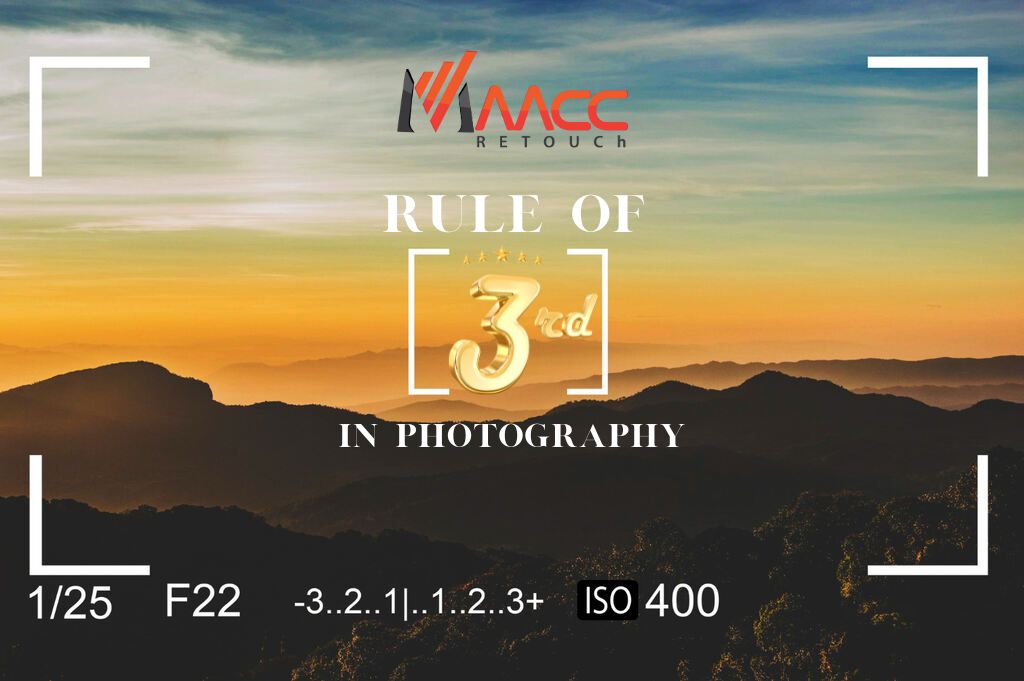What is the Rule of Thirds in Photography? Well, the rule of thirds is a fundamental principle in photography composition that divides an image into a grid of nine equal parts using two horizontal and two vertical lines. The intersections of these lines create focal points where important elements of the photograph can be placed.
By aligning key subjects or points of interest along these gridlines or intersections, photographers can create visually balanced and engaging compositions. The Rule of Thirds guides viewers’ eyes through the image and adds interest and dynamism to photographs. Keep reading to learn more.
What is the Rule of Thirds in Photography?
The Rule of Thirds is a widely recognized guideline in photography composition that helps create visually appealing and balanced images. It involves dividing an image into a grid of nine equal parts by drawing two equally spaced horizontal lines and two vertical lines. This grid forms four intersections and four lines that act as guides for placing important elements in the photograph.
The concept behind the Rule of Thirds is to avoid placing the subject at the center of the frame, which can result in a static and less interesting composition. Instead, photographers are encouraged to position key elements along the gridlines or at the intersections. These areas are known as “hotspots” and are considered visually compelling focal points.
By adhering to the Rule of Thirds, photographers can create a sense of balance, harmony, and visual flow within their images. It helps draw the viewer’s eye into the photograph and adds a dynamic quality to the composition. The Rule of Thirds is a versatile guideline that can be applied to various genres of photography, including landscapes, portraits, still life, and street photography.
Benefits of Applying Rules of Thirds
Applying the Rule of Thirds in photography offers several benefits that can enhance the composition and visual impact of your images.
Here are some key advantages:
Visual Balance
The Rule of Thirds helps create a balanced composition by distributing elements across the frame. Placing subjects or points of interest along the gridlines or at the intersections creates a sense of equilibrium and prevents the image from appearing too centered or static.
Dynamic Composition
By positioning key elements off-center, the Rule of Thirds adds a dynamic quality to your photographs. This draws the viewer’s eye into the image and encourages them to explore the entire frame, resulting in a more engaging and visually captivating composition.
Focus and Emphasis
Placing important subjects or focal points at the intersections of the gridlines helps draw attention and emphasize them within the frame. This technique can guide viewers’ eyes to the intended areas of interest and create a stronger visual impact.
Visual Flow and Leading Lines
The gridlines in the Rule of Thirds can be used as guidelines for leading lines, which direct the viewer’s gaze and create a sense of movement within the image. By aligning elements along these lines, you can establish a visual flow that guides the viewer’s eye through the frame, adding depth and interest to the composition.
Harmony with the Golden Ratio
The Rule of Thirds aligns with the principles of the Golden Ratio, a mathematical concept associated with aesthetically pleasing proportions. By incorporating the Rule of Thirds, your compositions can exhibit a harmonious balance that resonates with viewers.
Versatility
The Rule of Thirds is applicable to various genres of photography, from landscapes and portraits to still life and architecture. Its flexibility allows photographers to create visually appealing compositions regardless of the subject matter.
By applying the Rule of Thirds, you can elevate your photography by achieving a well-balanced composition, enhancing visual interest, guiding the viewer’s eye, and creating a sense of harmony and flow within your images.
Drawbacks of Applying The Rules of Thirds
While the Rule of Thirds is a widely used guideline in photography composition, it’s important to recognize that it’s not a one-size-fits-all solution. While it offers several benefits, there are also potential drawbacks to consider.
Here are some limitations and drawbacks of applying the Rule of Thirds in Photography below:
Lack of Originality
The Rule of Thirds is a well-known compositional technique, and relying solely on it can lead to predictable and clichéd compositions. Overusing this guideline may result in images that feel formulaic and lack creative uniqueness. It’s important to explore other compositional techniques and experiment with different approaches to maintain originality in your photography.
Restrictive Composition
Strictly adhering to the Rule of Thirds may limit your creative freedom and composition options. Placing subjects or key elements at the gridlines or intersections can sometimes feel forced or unnatural, especially when the image naturally lends itself to a different arrangement. It’s essential to consider alternative compositions that may better suit the subject or scene.
Ignoring Negative Space
The Rule of Thirds primarily focuses on placing subjects along the gridlines or intersections, potentially neglecting the effective use of negative space. Negative space, the empty areas surrounding the subject, can be a powerful compositional tool for creating balance, emphasizing the subject, or conveying a specific mood. Overemphasis on the Rule of Thirds may result in missed opportunities to utilize negative space creatively.
Subject Placement Challenges
Placing subjects directly on the gridlines or intersections can be challenging, especially when dealing with complex or asymmetrical subjects. In certain cases, the subject’s position may not align perfectly with the Rule of Thirds, making it difficult to achieve a strong composition without compromising the subject’s integrity. It’s important to prioritize the subject’s visual impact and adjust the composition accordingly.
Lack of Context and Balance
While the Rule of Thirds can create balance within an image, overreliance on this guideline may result in an imbalance between the subject and the surrounding elements. It’s crucial to consider the overall composition, including background elements, leading lines, and negative space, to ensure a harmonious and contextually rich image.
Incompatibility with Certain Subjects
Certain subjects or scenes may not lend themselves well to the Rule of Thirds. For example, symmetrical compositions, centered subjects, or highly dynamic subjects may require alternative compositional techniques to effectively convey the intended message or aesthetic. It’s important to adapt the compositional approach to suit the specific subject and scenario.
While the Rule of Thirds can be a helpful guideline, it’s essential to view it as a tool rather than a strict rule. It’s important to understand when and how to deviate from this guideline to create compelling and unique compositions. Ultimately, the goal is to develop a diverse compositional repertoire that allows for creative expression and captures the essence of the subject or scene effectively.
How To Apply The Rule Of Thirds in Photography?
Applying the Rule of Thirds in photography is a straightforward process that can greatly enhance your compositions.
Here are some practical steps to effectively utilize this guideline:
Activate the Grid
Most cameras and smartphone cameras offer an option to display a grid overlay on the screen. Enable this feature in your camera settings to visualize the Rule of Thirds grid while composing your shot.
Frame the Scene
Look through your viewfinder or use the grid on your camera screen to identify the key elements in your scene. Consider the subject, background, and any leading lines or prominent features that can be aligned with the gridlines.
Positioning the Subject
Place your subject along one of the vertical or horizontal gridlines, rather than at the center of the frame. This creates a more visually dynamic composition. For example, when photographing a landscape, position the horizon along either the top or bottom gridline instead of placing it in the center.
Intersection Points
Ideally, position important elements or focal points of interest in your scene at the intersections of the gridlines. These intersection points serve as natural visual attractors and can draw the viewer’s attention to specific areas within the frame. For example, if capturing a portrait, position the eyes or face along one of the upper intersections.
Balancing the Composition:
Consider the balance of elements within your frame. If your subject is positioned along one vertical gridline, try to include another significant element along a corresponding horizontal gridline to maintain balance and harmony in the composition. This can be achieved by including an interesting background element or using leading lines that guide the viewer’s eye.
Experiment and Refine
While the Rule of Thirds provides a useful starting point, don’t be afraid to experiment and deviate from it when necessary. Every scene is unique, and there may be instances where alternative compositions or techniques better suit your subject or creative vision. Trust your artistic instincts and adapt the composition accordingly.
Post-Processing Adjustments
If you didn’t apply the Rule of Thirds during shooting or want to fine-tune your composition, you can make adjustments during post-processing. Cropping the image to align key elements with the gridlines or intersections can help in achieving a more pleasing composition.
Remember, the Rule of Thirds is a guideline, not a strict rule. It’s a tool to assist you in creating balanced and visually engaging compositions. As you gain experience and develop your artistic style, you may find yourself naturally applying the Rule of Thirds or intentionally deviating from it to suit your creative vision.
Applying the Rule of Thirds in Landscape Photography
When incorporating the Rule of Thirds in landscape photography, you enhance the overall composition and visual appeal of your images. Begin by identifying key elements like the horizon, prominent landforms, or captivating foreground objects. Instead of centering the horizon, position it along the horizontal gridlines, adding depth and interest. Opt for the lower gridline to highlight a captivating sky or the upper gridline to emphasize an intriguing foreground.
Moreover, align vertical elements, such as trees or mountains, with the vertical gridlines to bring balance and structure to the composition. Incorporate leading lines, like roads or rivers, along the gridlines to guide the viewer through the scene, creating depth. Place focal points, such as a striking tree or rock formation, at the intersections of the gridlines for a visually pleasing and engaging composition.
Furthermore, effectively use negative space, such as open sky or vast bodies of water, to provide breathing room and emphasize the main elements. It adds scale and allows the primary subject to stand out against the emptiness.
Remember, while the Rule of Thirds serves as a helpful guideline, there are instances where intentional deviations can lead to unique compositions. Experiment, trust your artistic instincts, and adapt the rule to suit the specific landscape and your creative vision. By thoughtfully applying the Rule of Thirds, you can create stunning landscape photographs with balanced compositions that captivate viewers and convey the essence of the scene.
Applying the Rule of Thirds While Image Post Processing
While the Rule of Thirds is primarily a compositional guideline used during image capture, it can still be applied during the post-processing stage to enhance the overall composition and visual impact of your photographs.
Here are some ways to utilize the Rule of Thirds while post-processing your images:
Cropping
One of the most straightforward ways to apply the Rule of Thirds in post-processing is by cropping your image. Use the crop tool in your editing software to align key elements or subjects with the gridlines or intersections. This can help create a more visually pleasing and balanced composition by removing any distracting or unnecessary elements.
Adjusting Placement
If your image doesn’t align perfectly with the Rule of Thirds, you can still make adjustments to the placement of elements within the frame. For example, you can use tools like the transform or move tool to reposition important subjects or focal points slightly to align them more accurately with the gridlines or intersections.
Resizing and Rescaling
When resizing or rescaling your image, consider the Rule of Thirds for the overall dimensions. For example, if you’re preparing an image for a specific aspect ratio or print size, ensure that the main elements or focal points are positioned along the gridlines or intersections within the new dimensions.
Adjusting Background Elements
During post-processing, you have the opportunity to enhance or modify the background elements in your image. Apply the Rule of Thirds to guide the placement or adjustment of background elements such as skies, landscapes, or buildings. This can help create a more visually balanced composition and emphasize the main subject or focal point.
Overlay Guides
Some image editing software allows you to overlay the Rule of Thirds grid on your image during the post-processing stage. This visual guide can help you make more informed decisions when it comes to adjusting placement, cropping, or resizing. It allows you to see how the Rule of Thirds applies to your image and make adjustments accordingly.
Experimentation and Creative Freedom
While the Rule of Thirds provides a helpful guideline, don’t be afraid to deviate from it if it serves your creative vision better. Post-processing is an opportunity to explore different compositional choices and experiment with alternative placements, crops, or alignments. Trust your artistic instincts and use the Rule of Thirds as a tool rather than a strict rule.
Remember, the Rule of Thirds is just one of many compositional techniques available to photographers. It can be a powerful tool to create balanced and visually engaging compositions, even during the post-processing stage. However, it’s important to consider the specific image and your creative vision, making adjustments as needed to achieve the desired aesthetic and impact.
Final Words
The Rule of Thirds is a valuable guideline in photography that can greatly enhance the composition and visual impact of your images. By positioning key elements along the gridlines or intersections, it creates a sense of balance, harmony, and visual flow.
Whether applied during image capture or post-processing, the Rule of Thirds helps draw attention to focal points, guides the viewer’s eye, and adds depth to the composition.
While it’s important to remember that artistic experimentation and personal style play a significant role in photography, the Rule of Thirds serves as a reliable tool to create compelling and visually engaging photographs.






